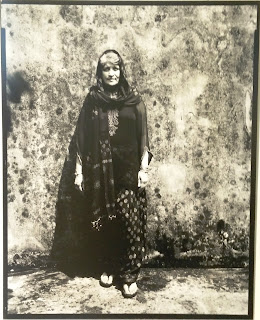“Clothing, in (Gaëtan Gatian de) Clérambault’s world, is considered a costume in the sense of a disguise, much in the same way as in folk traditions. (Diana Lui) transcends that exotic aspect staged by Clérambault. She spins around the codes and archetypes traditionally associated with such clothing by enhancing their symbolic value in a very lucid manner. This time, the photographer’s models, far from being instrumentalised, are given the full liberty to express their own story and their own interpretation of history in evolution through the traditional clothing they choose to wear.”
- Anne Biroleau-Lemagny, Curator in Photography Department at Bibliothèque Nationale de France
| Image may be NSFW. Clik here to view.  |
| Totem #10 (2015) |
Strolling around a spacious bungalow, one is drawn deeply to the exacting details in photographic portraits of women donned in ritual costume. In her insightful essay, Laura Fan describes the exhibited captures perfectly, “Diana Lui’s photographs of each subject strike an unusual balance between outward cultural affiliations displayed through their choice of ritual dress and deliberate signs of individuality. Signifiers such as tattoos or ancestral ritual jewellery reveal the elements of choice in the cultural affiliation of each person, and their right to represent themselves as they wish.” The majority of represented women have successful careers in artistic endeavours, and tend to come from families with mixed-ethnic ancestry.
| Image may be NSFW. Clik here to view.  |
| Totem #12 (2015) |
The exotic and the familiar repeatedly breaks and coalesces in the displayed images. Celebratory attires worn range from the elaborate to the elegant, from the monotonous to the colourful, from large ornaments to beaded patterns, from body-hugging curves to straight lines, from the pleated to the wrap-around. Each stately pose is accentuated by a backdrop of the model’s choice – house interiors, dirty walls, shaded outdoors – and the natural light that comes with these locations illuminate a subtle facet of each woman’s personality. Staring at them, it is a revelation to find out that these pictures were taken with a decades-old camera obscura, a romantic but effective metaphor for the act of gazing.
| Image may be NSFW. Clik here to view.  |
| Installation snapshot of (2015) [l] Totem #8, and [r] Totem #9 |
Diana makes it clear that she is investigating her “…own identity as well as other women’s…”, by placing herself in between the wooden box and expressionist paintings, her hand seen holding a trigger connected to the camera’s shutter. The artist’s image undergoes the same deliberate and thorough visual scrutiny as the other portraits, although the black cloth she wears denotes an identity void within Malaysian cultural references. Traditional dress is recognised as inherited culture and occasional splendour, where the contemporary individual can appreciate its elegance to go with one’s hair colour or body tattoo.
| Image may be NSFW. Clik here to view.  |
| Totem #13 (2015) |
The most striking picture is of one Sabahan bead artist standing within Kota Kinabalu’s infamous graffiti building, her natural poise not giving away any information as stated in the wall notes, which describes the model as a recent Muslim convert who found beads in Mecca that were similar to her grandmother’s heirloom beads. Such supplementary explanations of personal stories, ethnic origins, and clothing histories, allow casual visitors to clarify assumptions and perceptions. ‘Nationality: Malaysian…’ are the first words printed on each label, this fact rendered redundant with the diverse figures on show. In a society that emphasises one’s nationality as a sign of belonging, these confident women in their humble abodes, become assuring icons of individual agency.
| Image may be NSFW. Clik here to view.  |
| Totem #6 (2015) |
Hung in the same venue are photographs from “The Essential Veil” (soon showing at Wei-Ling Gallery), Diana’s previous series that employs the same conceptual starting point as “Totem”. Local context marks the Malaysian series as more captivating, where a stunning pair of coupled portraits feature one Odissi dancer, and one Mah Meri weaver. Pictures of the latter woman present the model in her bark fabric wedding dress, the frontal capture in colour. Her back is shot in black & white, the image easily mistaken for a snapshot of indigenous people found in history books. Looking back at our roots, do I see the collective persona, or the individual personality? What contemporary view colours my vision? How many self-portraits do I need to take, before making my own?
| Image may be NSFW. Clik here to view.  |
| Installation snapshot of (2015) [l] Totem #5, and [r] Totem #5a |